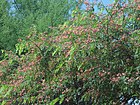Note: This is a project under development. The articles on this wiki are just being initiated and broadly incomplete. You can Help creating new pages.
Cassia roxburghii - Red Cassia
Red cassia is a graceful tree with spreading, drooping branches appearing to be overweighted. Typically the bark of the cassia tree is considered to be a substitute for cinnamon and it is known to produce a volatile oil that is very similar to cinnamon Oil.
Contents
[hide]Uses
Diabetes, Gastric problems, Muscle spasms, Nausea, Vomiting, Blotches, Infections, Diarrhea, Cold, Stomach spasms
Parts Used
Chemical Composition
Hexacosanol, 1‐octacosanol, palmitic acid, stearic acid, oleic acid, linoleic acid, heptacosyl [1]
Common names
| Language | Common name |
|---|---|
| Kannada | |
| Hindi | |
| Malayalam | |
| Tamil | |
| Telugu | |
| Marathi | NA |
| Gujarathi | NA |
| Punjabi | NA |
| Kashmiri | NA |
| Sanskrit | |
| English | Red Cassia, Ceylon Senna |
Habit
Identification
Leaf
| Kind | Shape | Feature |
|---|---|---|
| Simple | 1 ft (0.3 m) | Each has 15-20 pairs of oblong 2 in (5.1 cm) leaflets |
Flower
| Type | Size | Color and composition | Stamen | More information |
|---|---|---|---|---|
| Unisexual | 0.5 in (1.3 cm) long | Pink, rose or orange | 5 | Flowers Season is June - August |
Fruit
| Type | Size | Mass | Appearance | Seeds | More information |
|---|---|---|---|---|---|
| Typivcal legume | 8-12 in (20.3-30.5 cm) long | Bears many seeds separated by papery partitions | With hooked hairs | Many | {{{6}}} |
Other features
List of Ayurvedic medicine in which the herb is used
Where to get the saplings
Mode of Propagation
How to plant/cultivate
If you live in an area that meets the requirements of how hardy is a cassia tree, planting a cassia tree can be a striking addition to your landscape.[3]
Commonly seen growing in areas
Western ghats, Cultivated lands, Tropical area.
Photo Gallery
References
External Links
- Ayurvedic Herbs known to be helpful to treat Diabetes
- Ayurvedic Herbs known to be helpful to treat Gastric problems
- Ayurvedic Herbs known to be helpful to treat Muscle spasms
- Ayurvedic Herbs known to be helpful to treat Nausea
- Ayurvedic Herbs known to be helpful to treat Vomiting
- Ayurvedic Herbs known to be helpful to treat Blotches
- Ayurvedic Herbs known to be helpful to treat Infections
- Ayurvedic Herbs known to be helpful to treat Diarrhea
- Ayurvedic Herbs known to be helpful to treat Cold
- Ayurvedic Herbs known to be helpful to treat Stomach spasms
- Herbs with Leaves used in medicine
- Herbs with Bark used in medicine
- Herbs with common name in English
- Habit - Tree
- Index of Plants which can be propagated by Seeds
- Index of Plants which can be propagated by Cuttings
- Herbs that are commonly seen in the region of Western ghats
- Herbs that are commonly seen in the region of Cultivated lands
- Herbs that are commonly seen in the region of Tropical area
- Herbs
- Ayurvedic herbs that don't have seed photos
- Fabaceae









